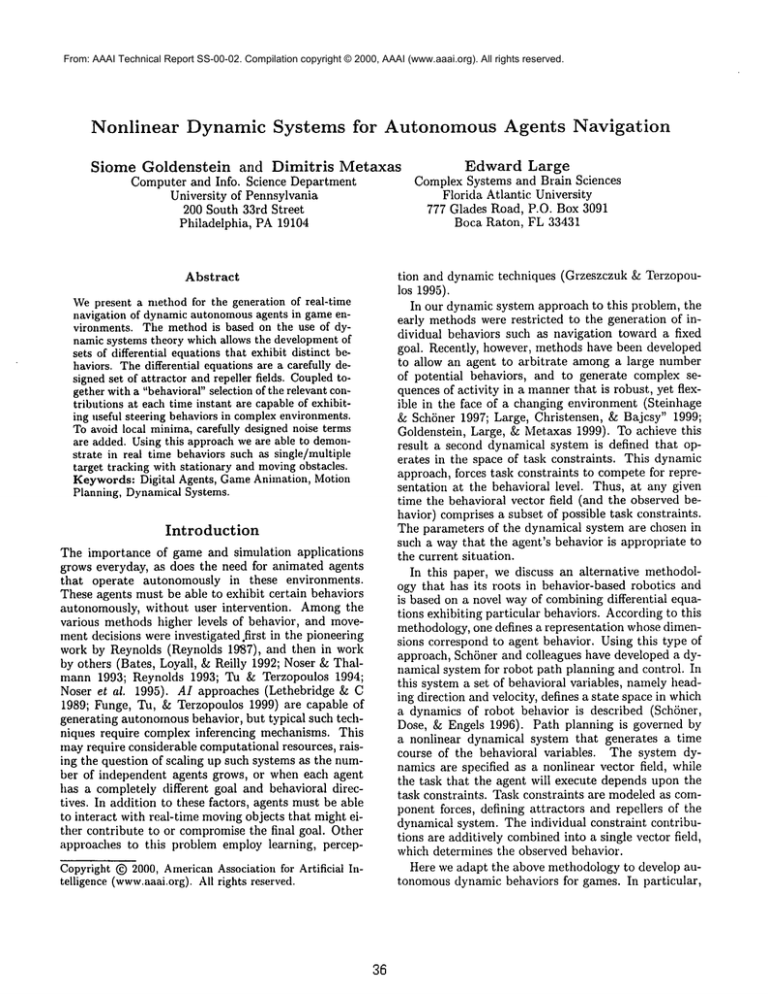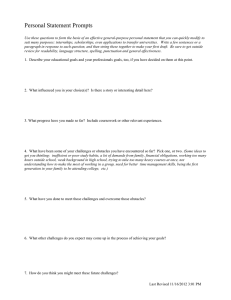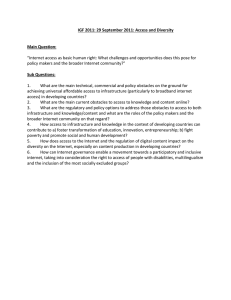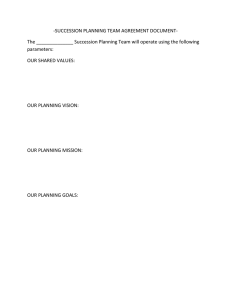
From: AAAI Technical Report SS-00-02. Compilation copyright © 2000, AAAI (www.aaai.org). All rights reserved.
Nonlinear
Siome
Dynamic Systems
for
Goldenstein
and Dimitris
Metaxas
Computer and Info. Science Department
University of Pennsylvania
200 South 33rd Street
Philadelphia, PA 19104
Abstract
Wepresent a method for the generation of real-time
navigation of dynamicautonomousagents in game environments. The method is based on the use of dynamic systems theory which allows the developmentof
sets of differential equations that exhibit distinct behaviors. The differential equations are a carefully designed set of attractor and repeller fields. Coupledtogether with a "behavioral" selection of the relevant contributions at each time instant are capable of exhibiting useful steering behaviors in complexenvironments.
To avoid local minima, carefully designed noise terms
are added. Using this approach we are able to demonstrate in real time behaviors such as single/multiple
target tracking with stationary and movingobstacles.
Keywords: Digital Agents, GameAnimation, Motion
Planning, Dynamical Systems.
Introduction
The importance of game and simulation applications
grows everyday, as does the need for animated agents
that operate autonomously in these environments.
These agents must be able to exhibit certain behaviors
autonomously, without user intervention.
Amongthe
various methods higher levels of behavior, and movement decisions were investigated .first in the pioneering
work by Reynolds (Reynolds 1987), and then in work
by others (Bates, Loyall, & Reilly 1992; Noser & Thaimann 1993; Reynolds 1993; Tu & Terzopoulos 1994;
Noser et al. 1995). AI approaches (Lethebridge &
1989; Funge, Tu, & Terzopoulos 1999) are capable of
generating autonomousbehavior, but typical such techniques require complex inferencing mechanisms. This
mayrequire considerable computational resources, raising the question of scaling up such systems as the number of independent agents grows, or when each agent
has a completely different goal and behavioral directives. In addition to these factors, agents must be able
to interact with real-time movingobjects that might either contribute to or compromisethe final goal. Other
approaches to this problem employ learning, percepCopyright (~) 2000, AmericanAssociation for Artificial Intelligence (www.aaai.org).All rights reserved.
Autonomous Agents
Navigation
Edward
Large
Complex Systems and Brain Sciences
Florida Atlantic University
777 Glades Road, P.O. Box 3091
Boca Raton, FL 33431
tion and dynamic techniques (Grzeszczuk & Terzopoulos 1995).
In our dynamic system approach to this problem, the
early methods were restricted to the generation of individual behaviors such as navigation toward a fixed
goal. Recently, however, methods have been developed
to allow an agent to arbitrate among a large number
of potential behaviors, and to generate complex sequences of activity in a mannerthat is robust, yet flexible in the face of a changing environment (Steinhage
& SchSner 1997; Large, Christensen, & Bajcsy" 1999;
Goldenstein, Large, & Metaxas 1999). To achieve this
result a second dynamical system is defined that operates in the space of task constraints. This dynamic
approach, forces task constraints to compete for representation at the behavioral level. Thus, at any given
time the behavioral vector field (and the observed behavior) comprises a subset of possible task constraints.
The parameters of the dynamical system are chosen in
such a way that the agent’s behavior is appropriate to
the current situation.
In this paper, we discuss an alternative methodology that has its roots in behavior-based robotics and
is based on a novel way of combining differential equations exhibiting particular behaviors. According to this
methodology, one defines a representation whose dimensions correspond to agent behavior. Using this type of
approach, SchSner and colleagues have developed a dynamical system for robot path planning and control. In
this system a set of behavioral variables, namely heading direction and velocity, defines a state space in which
a dynamics of robot behavior is described (SchSner,
Dose, & Engels 1996). Path planning is governed by
a nonlinear dynamical system that generates a time
course of the behavioral variables. The system dynamics are specified as a nonlinear vector field, while
the task that the agent will execute depends upon the
task constraints. Task constraints are modeled as component forces, defining attractors and repellers of the
dynamical system. The individual constraint contributions are additively combinedinto a single vector field,
which determines the observed behavior.
Here we adapt the above methodology to develop autonomous dynamic behaviors for games. In particular,
we devise a set of time adaptive differential equations
to rule the heading angle and forward speed of a given
digital autonomous agent. Based on a principled combination of these equations we create a whole set of
relatively complex "low-lever’ behaviors which are reactive in nature. To avoid unstable fixed points in the
differential equations I we add a Gaussian noise term in
each equation. Using this system decisions are made
on-line and do not require any previous memory,training or global planning. The set of targets and obstacles
can change during the course of the simulation, since
the agent is able to make "smart" local decisions based
on its current global knowledge of the dynamic environment it is situated. An example of such a behavior
is that the agent will temporarily disregard a target if
there is an unsurpassable moving/stantionary obstacle
immediately between them. It will then focus like a
human would do to first avoid the obstacle and then
refocus on the target.
Our system allows single/multiple target tracking in
the presence of multiple static/moving obstacles. The
design of the differential equations allows the tracking of
targets whenevertheir position is within the visible cone
of an agent requiring only the estimation of its current
position. However, obstacles are processed in a local
fashion based on their relative location to the agent
and the target. Given our applications, in our current
implementation our agents are memoryless, reactive in
nature and depending on the situation (emergence of
new obstacles and/or targets) their movementcan be
discontinuous.
In the following sections, we present previous related
work in the area, the design of our system and the series
of real-time experiments.
Movement
targets (Section. In our formulation, the heading speed
is modified by either the heading angle information or
the relative location of the obstacles (Section).
Based on our formulation, an agent ignores targets
or obstacles, depending on the scene geometry around
the agent at each time instance. It is modeled based
on another type of nonlinear dynamical system, running on a more refined time scale. This system outputs weights that linearly combine the different attractor and repeller contributions as calculated by the first
system. An important aspect of our methodology is
that it scales linearly with the numberof obstacles and
targets in the environment.
In the following we present the details of each of each
of the two dynamical systems.
The
Basic
Movement
Dynamics
The first dynamical system models the control of the
basic movement of each autonomous agent. The movement is defined by a 2D vector representing the agent’s
heading angle and forward speed.
The heading angle ¢ of a given agent is controlled by
a dynamical system of the type:
-- f(env),
(1)
where env is the vector of variables which models the
environment (e.g., the geometry and position of the obstacles and targets) and we describe in detail below.
According to our dynamical system formulation each
element of the environment can "attract" or "repel" an
agent. Wewill therefore use attractors to model targets
and repellers to model objects that should be avoided.
Wemodel an attractor as
Dynamics
ftar = a sin(¢ - ¢),
In our methodology we combine two distinct dynamic
systems to model the movement and behavior of each
autonomous agent. The first system controls the movement of the agent. The state space of this system is two
dimensional, the first parameter.represents the heading direction, while the other spe~:ifies its velocity. The
second system controls the agent’s movementdecision
making, i.e., its behavior. The state space of this system is the space of the agent’s behaviors. The parameter values of the state vector components determine
which "elements" of the environment (e.g., obstacles,
targets) will be used in the calculation of the agent’s
movementand therefore behavior.
Each autonomous agent movementis described in polar coordinates. It consists of a heading direction ¢ and
a forward velocity v. The heading angle is controlled by
a one dimensional non-linear dynamical system, which
consists of "repellers" placed in the subtended angle of
the obstacles, and attractors in the subtended angles of
(2)
where ¢ is the angle of the target’s location relative to
the agent’s location and a is a constant parameter.
In order to model complex environment obstacles, enemies or hazards are distinct entities. Fire-pits, for example, are clearly more dangerous than a large wall.
Therefore the repeller definition should have enough
parameters to model the different types of objects. We
achieve this by defining a repeller to be the multiplication of three different functions, Ri, Wi, Di, which result
in being able to modelthe type of repeller, its distance
to the agent and the extent of its influence to the environent. Wetherefore repeller as
Yobs,= Ri WiDi.
Function Ri models a generic repeller,
structed as:
Ri = (¢
¢i) (~-~--=~
-- - e~
~",
J,
lIn differential equation terminologya fixed point is a
point where the derivative is zero and acts like a trap resulting in the agent not to be able to move.
(3)
and is con-
(4)
where ¢i is the angle of obstacle i and A¢i is the angle
subtended by it.
37
The second function, WI, is responsible for limiting
the angular range of the repeller’s influence in the environment and is modeled as
graphic) and obstacle function (middle right graphic).
The presence of two final attractors, indicated by the
two arrows in the lower right graph, show the two possible obvious ways to get to the target and avoid the
obstacle.
1
Wi = ~[tanh(hl (cos(¢ - ¢i) -
cos(2a¢+ o))) + 1],
°..~,o,
~J
which models a window-shaped function and hi is responsible for the inclination of the window’ssides and
is modeled by
,~lv
ht = 4/(cos(2A¢) - cos(2A¢ + (i)).
Here (i is a "safety margin" constant.
The third and last function, Di, models the influence
of the obstacle to the environment by taking into account the distance of the obstacle from the agent and
is modeled as
Di = e -~0 ,
Figure 1: Attractor and Repeller interaction.
A second more complex example consists of the agent
facing two different obstacles located side by side. If
the obstacles are too far apart, the agent should be
able to pass between them, otherwise it will have to
go around them. This decision is taken automatically,
as it can be seen in Fig.. Fig. 2(a) depicts the case
where two obstacles are too close, Fig. 2(b) depicts the
case where the distance between the obstacles is exactly
equal to the size of the agent, a critical condition, and
Fig. 2(c) depicts the case when the obstacles are far
apart to allow the easy passage of the agent between
them. For this simple case (no target and two obstacles)
we have plotted at the bottom of each figure (9) as
function of the angle between the agent orientation and
the y axis (assuming that the noise term n is zero).
These functions clearly show that the dynamical system
exhibits the correct behavior in terms of the value of the
¢. For example in Fig. 2(a) ~ = 0 depicts an unstable
fixed point which would result in the agent trying to
go through the obstacles. However, the insertion of a
small amount of noise n will overcome this situation
easily given the function diagram.
(7)
where ri is the relative distance between them, and do
controls the strength of this influence as the distance
changes.
The resulting influence on the agent from all obstacles
i = 1,... , n, is the sumof the respective repellers
n
fobs = ~ fobs,.
po a
(8)
i=1
Therefore, the definition of the dynamical system
controlling the heading angle in (1) is obtained as:
= f(env) == IWtarlftar -t- IWobslfobs + n. (9)
The weights Wtar and Wobsare intended to eliminate
spurious attractors that can occur by the direct summing of the nonlinear functions modeling the various obstacles and targets in the environement. These
weights are obtained through a "constrain competition", the second dyanamical system mentioned previously and described in details in Section. They are the
essence of the "low-level" behavior modeling. Finally,
the noise term n is an extremely important factor. It
allows the system to escape from unstable fixed points
in the definition of (9) (e.g., the "center" of a repeller,
where ~ = 0, but any slight diplacement would make it
escape from such a situation such as the situation of a
ball situated on the crest of a hill).
All the above functions are carefully designed so that
certain expected actions will appear in the final system.
Let’s first consider a simple example(Fig.), the result
of a simple interaction between a target, an attractor,
and an obstacle, a repeller. Let’s also take the simple
case that the location of the obstacle is close to the
straight line between the agent and the target.
It is then clear that the agent, will have to go around
the obstacle in order to hit the target. In this case,
the modeling of the agent’s heading direction ¢ based
on (9) is shown in tile lower right graph of Fig..
is the composition of the target function (upper right
©9
©©
(a)
(b)
(c)
Figure 2: Interaction of repellers of two obstacles.
Constrain
Competition
Individually, the attractors and repellers defined in section work well, but because of their non-linear characteristics their direct sum might not always yield the
expected results. For instace, in the example shownin
38
leads to a situation where the target and the obstacle
contributions in (9) are turned off. Obviously this case
should be avoided, because the agent would move in
an unpredictable way. To avoid this situation, both ai
should always be greater than zero.
The second case (Wtar,Wobs)
= (0, 1) occurs when
the target’s contribution is turned off (like in the case
of Fig. ). It is stable as long as ~obs,tar > O~tar.
The third case (Wtar,Wobs) = (1,0) happens
obstacles are ignored. This may occur, for example,
when there are no obstacles near the target. This case
is stable when")’tar,obs > Otobs"
The last case is when the values of both weights
are nonzero, (wt~,Wobs) = (Atar,Aobs), also known
as the "averaging" solution. The following two conditions have to be satisfied for this case to be stable
O~obs > ~tar,obs
and O~tar > ~obs,tar.
This is definetely a
desirable situation.
It is important to note that conditions two and three
are not mutually exclusive, and they can happen simultaneously. In this case we have a situation of bistability,
where the stable condition that will prevail depends on
the initial conditions. In this case there can be constant
alternation between behaviors. A possible solution to
avoid this problemis to give a "hysteresis" to the changing of the weights.
Based on the above, the design of ai and 7ij should
create the different stable points according to the environment parameters. This process is described with
details in (Large, Christensen, & Bajcsy" 1999), and
the functions for this two-dimensional case are:
Figure 3: Attractor of the angle dynamical system.
Figure, the sum of one attractor with the two repellers
propose an impossible path inbetween the two obstacles
- they are too close from each other to allow the agent’s
passage.
To avoid this kind of problem, the composition of the
attractors and repeller functions is not obtained by a direct sum, but though an weighted average by weights
wi. These weights are the result of the second dynamical system, which runs at a more refined time scale
wrt the dynamical system in (9). This second system
is modeled as
=
(10)
7j,iWjWi,
j#i
where in the simple case where only obstacles and
targets are modeled, the state space (wi) consists of
(Wtar, Wobs),as used in (9).
This system is completely defined by the parameter
functions ai, termed competitive advantage, the parameter functions 7ji, termed competitive interaction, and
the initial value of its state space. At each time instant these parameters will be computed according to
the geometry of the environment, and through (10)
obtain the weights to be used in (9). At a given time
instance in the computation of (9), the computation
the weights based on (10) is not done in one step but
in multiple steps. This is in order to ensure that the
computedweights result in a stable fixed point of (10)
as we will explain below. This explains why the whole
system runs in multiple time scales - (10) is evaluated
at a muchfaster rate compared t 9 (9).
The correct design of the parameter functions ai and
"~ji will provide the desired low level behaviors. Therefore it is important to understand the stability of this
system (for more details see (Perko 1991)), and incorporate the geometry of the environment in the "low-level"
behaviors. Table 1 showsthe stability analysis for (10):
~lity
0
0
4-1
4-¢4ta
r
0
4-1
0
4-Aobs
Unstable
Stable
Stable
Stable
and
O:tar,
O/obs
e-c2 Pta~ Pob.
obs,tar
---2
> O~tar
")’tar,obs
> ~obs
"[tar,obs
: 0.05
n
aobs = tanh ~ Di
i=1
where Pt~ and Pob~ are:
~lF’
Pt~ ~l
= sgn(dd~)e
(11)
.dFob~. calfob I
Pobs = Wobssgn(--~)e
(12)
and also at,~ is such that wheneverthere is competition
amongtargets and obstacles, targets will loose, but it
will always be active if there is only a "background"
noise. This is set here to be 0.4(1 - aobs). Di (7)
the function used in the distance contribution of each
obstacle repeller, and their sum gives a good estimative
of the concentration of obstacles around and near the
agent.
> 0
")’obs,tar
ec
Modeling the Agent’s
Velocity
Many different approaches can be used for modeling
the forward velocity. A possible approach is to assign a
constant value to the forward velocity. This approach
has drawbacks in a real time changing environment: if
an obstacle is suddenly in front of the agent, there might
not be enough time for the agent to change direction
aobs > "/tar,obs
O~tar > ~’obs,tar
Table h Stability Analysis.
There are four distinct cases each one related to a
different behavior. The first case, (Wtar,Wobs) = (0,0)
39
and will result in a collision. A better approach is to
have the agent move faster when there are no objects
around and slower in a crowded area. The agent should
also retreat when it is too close to an obstacle. An
equation for the forward velocity that satisfies the above
design criteria is the following
v
-
rmin -- dl
t2c
’
(13)
where rmin is the distance to the closest obstacle, dl
the safety distance and t2c is the time to contact. This
method basically applies a constant time to contact approach. If the closest obstacle is far then the forward
velocity is large. Also if the closest obstacle is at a distance smaller than dl, then the resulting forward velocity will be negative, meaningthat the agent will retreat.
Note that only obstacles in front of the agent should be
considered for this calculation. Wehave used the above
method in all our examples.
Experimental
Results
The system was implemented
in C, using lua
(R. Ierusalimschy & Celes 1996) as an extensible embedded language to describe both the scene and the
target(s)/agent(s)
movement.
The constant
a in (2) was set to 1 and the
safety margin 6 in (6) was set to 0.8. The Euler integration time step was 0.25 and all the simulations run in faster than real time.
All experiments described below can be found on-line at
http : //www.cis. upenn, edu/.~ siome/research/aaai2 00 0
In the first experiment we used a single static target
and a series of static obstacles between it’s location and
the target’s initial position. Note that in this case do
was 3.0.
In the second experiment the scene is composed of
one static target and multiple moving obstacles. The
agent avoids colision by changes of direction and sometimes by a velocity reduction or even a complete stop.
In this simulation do was set to 2.0.
In the third experiment there is a group of static
obstacles and a moving target. ,The agent successfully
reaches the target and avoids the moving obstacles. In
this case do was set to 0.8 and the final velocity was the
result of the methodscaled by 0.8.
In the last experiment we illustrate the flexibility of
our method by showing multiple moving and static targets together with moving and static obstacles . The
constant do was set to 1.0.
In the videos all experiments appear rendered based
on the use of the rendering package Pov-Ray.
Conclusions
We have presented a technique to model autonomous
agents navigation for game environments. Using a dynamical system approach we control the agent’s heading direction and its velocity. Wehave demonstrated
natural low-level agent behavior in envirnments with
multiple targets and stationary/moving obstacles.
40
There is a whole set of parameters to control the expected low-level behavior of the overall system. Unfortunately this set is not intuitive for an animator. We
are currently working towards making the whole process of modeling a behavior both more high-level and
"user-friendly" as well as flexible enough for different
applications. Newfunctions are being analyzed in order to achieve a significantly larger and more complex
set of behaviors.
Acknowledgments
The first author was supported by a Ph.D fellowship
from CNPq, Brazil. The second author was partially
supported by an ONRYIP and an NSF Career Award.
References
Bates, J.; Loyall, A.; and Reilly, W.1992. Anarchitecture
for action, emotion, and socialbehavior. In Proceedingsof
the Fourth Europeans Workshop on Modeling Autonomous
Agents in a multi Agents World.
Funge, J.; Tu, X.; and Terzopoulos, D. 1999. Cognitive
modeling: Knowledge,reasoning and planning for intelligent characters. Proc. of SIGGRAPH
99 29-38.
Goldenstein, S.; Large, E.; and Metaxas, D. 1999. Nonlinear dynamical system apprach to behavior modeling.
The Visual Computer15:349-369.
Grzeszczuk, R., and Terzopoulos, D. 1995. Automated
learning of Muscle-Actuated locomotion through control
abstraction. In Proc. of SIGGRAPH.
Large, E.; Christensen, H.; and Bajcsy", R. 1999. Scaling the dynamic approach to path planning and control:
Competition amongbehavioral constraints. Int. Journal
of Robotics Research18(1).
Lethebridge, T., and C, C. W.1989. A simple heuristicallybased methodfor expressive stimulus-response animation.
Computersand Graphics 13(3).
Noser, H., and Thalmann, D. 1993. L-system-based behavioral animation. In Proc. Pacific Graphics.
Noser, H.; Renault, O.; Thalmann, D.; and Thalmann.,
N. 1995. Navigation for digital actors based on synthetic
vision, memoryand learning. Computerand Graphics.
Perko, L. 1991. Differential Equations and DynamicalSystems. Springer Verlag.
R. Ierusalimschy, L. F., and Celes, W. 1996. Lua - an
extensible extension language. Software: Practice 8J Experience 26(6).
Reynolds, C. 1987. Flocks, herds, and schools: A distributed behavioral model. In Proc. SIGGRAPH
’87.
Reynolds, C. 1993. An evolved, vision-based behavioral
modelof coordinated group motion. In Proc. $nd Int. Conf.
on Simulation of Adaptive Behavior.
Sch6ner, G.; Dose, M.; and Engels, C. 1996. Dynamicsof
behaviour: theory and applications for autonomousrobot
architectures. Robotics and AutonomousSystems 16(2-4).
Steinhage, A., and SchSner, G. 1997. The dynamic approach to autonomous robot navigation. In Proc. IEEE
Int. Symposiumon Industrial Electronics.
Tu, X., and Terzopoulos,D. 1994. Artificial fishes: Physics,
locomotion, perception, behavior. In Proc. of SIGGRAPH.



